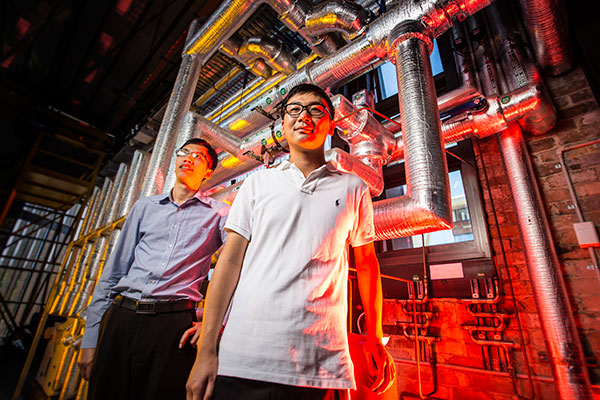March 11, 2015
Getting to the source of energy efficient living
Researchers find the equation to get sustainable energy for less money out of a hole in the ground.

Dr Zhenjun Ma (left) and PhD student Su Huang with the SBRC ground source heat pump..
Researchers at UOW’s Sustainable Buildings Research Centre (SBRC) are studying the use of ground source heat pumps, to help provide a sustainable energy supply and cut power bills.
Ground source heat pumps use water or other liquids in pipes buried underground to exchange heat with the soil, dispersing warmth to soil in summer and collecting heat from the ground in winter that can then be used inside a building.
Ground source heat pumps have a longer life span and are more energy efficient than conventional heating and cooling systems.
Yet, the high system upfront cost as well as limitations on land required to bury the pipes often limit its use as a sustainable energy option for homes and businesses.
To get sustainable energy and reduce overall costs, PhD student Su Huang, supervised by Dr Zhenjun Ma and Professor Paul Cooper have developed a way of determining the optimum set up and operation for ground source heat pump systems.
Their simulation tests based on the SBRC building delivered a 9.5 per cent overall system cost saving, including system installation cost and 20-year operating costs.

Water flowing through pipes buried underground exchange heat with the soil, providing heating and cooling year round at SBRC.
Su considered a number of variables including the depth of the buried pipes, size of pipes, and the number of underground loops to optimize the system design as well as fine-tuning its performance using different water flow rates to find the ultimate balance between efficiency and system installation costs.
“To increase the efficiency of ground source heat pumps to make further energy cost savings the user could put in a larger system but this drives up the cost,” Su Huang said. “They could always lower the up-front costs by reducing the size of the system, but inappropriate decrease of the system size can reduce energy efficiency of the system and increase the operating costs.
“We want to make sustainable energy production through these systems attractive to people so it’s important to find the optimum design that provides as much energy savings as possible to offset those upfront costs.”
The design optimisation method was also applied to a large-scale ground source heat pump attached to a three-storey dining hall at Xi’an Jiaotong University, Xi’an, China, and produced similar simulation results.
A large portion of household energy costs are for heating and cooling and ground source heat pumps provide a sustainable option, with large market potential for new developments and new commercial buildings.
| related stories |
|---|
The test system installed at SBRC, supplied by research partner GeoExchange Australia, produces a substantial amount of the building’s year-round energy needs. Integrated with other renewable energy systems, such as solar, the building produces more energy than it requires.
Dr Zhenjun Ma said people were increasingly interested in sustainability and energy efficiency with a desire for net-zero energy buildings.
“This technology is one of the options and our contribution is to make research available that aids design and operational optimisation,” he said.
Dr Ma said the next step in their research was to make use of solar energy to warm the ground and further improve the performance of the heat pumps, particularly in cold climates.
The research was published recently in the journal Energy and Buildings.